In the midst of the third outbreak of E. coli linked to romaine lettuce in less than two years, the Centers for Disease Control and Prevention (CDC) urges consumers to avoid buying or eating any romaine lettuce.
In this recent outbreak, the CDC is reporting that 32 people in 11 states have been infected with E. coli O157:H7, a serotype of the bacteria that causes foodborne illness. So far, 13 people have been hospitalized, including one person who developed hemolytic uremic syndrome, a type of kidney failure. No deaths have been reported to date.
Consumers are urged to avoid all types of romaine lettuce: whole heads of romaine, hearts of romaine, chopped romaine, and salad and salad mixes containing romaine.
University of Georgia Cooperative Extension Food Processing and Safety Specialist Anand Mohan has a slogan for this situation: “When in doubt, throw it out.”
“If you are served romaine lettuce in a restaurant, please do not eat it. If you have any type of romaine lettuce in your home, throw it away, even if you have eaten some of it,” he said.
If you have purchased a salad mix and are unsure if it contains romaine lettuce, do not eat it and throw it away, Mohan said.
As an additional safety measure, Mohan says that consumers should sanitize all drawers or shelves in refrigerators where romaine lettuce was stored.
Last spring’s outbreak linked to romaine lettuce from Yuma, Arizona, was traced back to the presence of a large cattle feedlot in the area, said Professor Francisco Diez, director of the UGA Center for Food Safety.
“This latest event is, unfortunately, corroborating our realization that the implementation of preventive measures is urgently needed. The impact to the produce industry will be regrettably enormous,” Diez said. “The strain causing this latest outbreak appears to be almost identical to the one responsible for the 2017 outbreak that implicated leafy greens in the U.S. and romaine lettuce in Canada, but it is different from the one earlier this year.”
Moving forward, UGA Extension Food Safety Specialist Judy Harrison says that cleaning the surface of leafy greens, like lettuce, can be difficult because of the natural openings in the leaves of the plant, which it uses for respiration. Bacteria can get inside the plant through these openings or through damaged areas and be protected there. If this happens, pathogens may not be removed by washing the lettuce.
To reduce the risk of eating contaminated produce, heads of lettuce and other greens should be cleaned as before eating. Harrison recommends discarding the outermost leaves before washing the remainder with running water, two to three leaves at a time. A single-use paper towel should be used to dry the leaves, which may help to remove more pathogens, if present.
When purchasing precut or bagged produce that is labeled “prewashed” or “ready-to-eat,” washing the produce again at home is not necessary and may instead create opportunities for it to become contaminated, she said.








